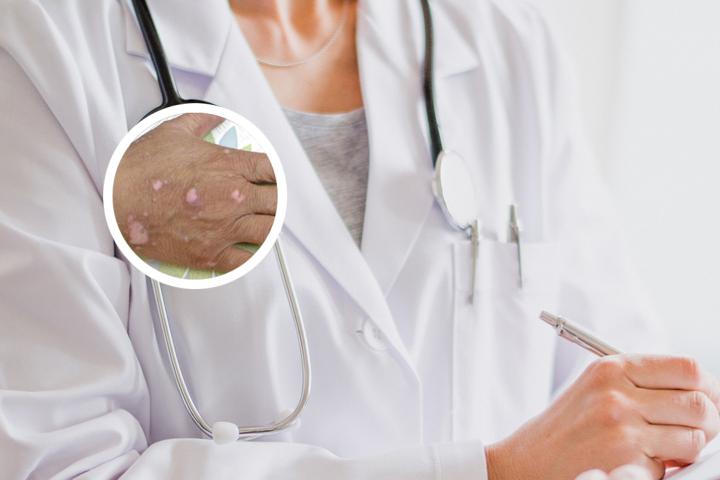首段

白癜风是一种常见的色素失调性疾病,其主要病变部位为皮肤。这种疾病会导致皮肤上局部或全身范围内的色素消失或减少,出现白癜风和色素不均匀的现象。白癜风患者通常会感到精神上的痛苦,因此需要及时诊断和治疗。
第二段
白癜风是一种复杂的疾病,具有多种原因和危险因素。遗传、自身免疫等因素均可能对白癜风的发生起到重要作用。从临床实践来看,受到创伤、感冒、手术、精神刺激等因素影响的患者也容易在短时间内发病。此外,某些药物也会加重或诱发白癜风的发生。

第三段
目前,治疗白癜风主要采用的是药物治疗和光疗治疗。药物治疗可以经过外用药和口服药等多种方式进行。其中,外用药大多数以促进色素合成和抑制自身免疫反应为主,例如激素、钙调素等。但是其治疗效果较慢,且不同患者的治疗效果也有较大差别。光疗治疗则有UVB、PUVA等多种方式。这种治疗方法的优点在于可以改善局部的色素合成,并提高白癜风处皮肤的色素含量,其副作用通常较小,但需要定期进行治疗,疗程较长。此外,部分患者需要针对性的治疗根据患者特点选择最佳治疗方案。总而言之,根据医生的建议和个人情况,在治疗白癜风方面必须是一个全面的治疗方法,同时还应注重锻炼和营养均衡,保持良好的生活习惯。
白癜风药品清单计划表格
白癜风是一种常见的皮肤病,它会导致色素脱失,使患者的肌肤出现白色斑块或斑点,导致外观上的变化。药物疗法是当前治疗白癜风的一种主要方法。因此,制定一份白癜风药品清单计划表格非常重要,以协助专业医生更好地选择用药方案,帮助患者尽早恢复健康。

首先,需要列出适用于白癜风患者的药物。这些药物包括外用药和内服药,如四环素、维生素D3、免疫抑制剂、激素等常规治疗药物。除此之外,还有一些新型药物如:JAK抑制剂、B2B蛋白、PD-1抑制剂等,值得推荐给指定适应人群。
其次,需要对这些药物进行详细分类,分别将其列入处方药、OTC药、中成药和其他类别。处方药通常被认为是治疗白癜风最有效的药物之一,可以通过医生的处方购买。OTC药是指不需要处方,患者可以自己购买和使用。中成药是指按照传统中医理论制定的治疗配方,通常也需要医生的处方才能购买。其他类别包括营养补充剂、整容美容产品和其他非处方药。
最后,需要在清单中标注每个药物的适用症、禁忌症、用法用量、不良反应等信息。这些信息对于医生开药给患者非常重要。例如,维生素D3缺乏通过口服补充时,如果患者血钙含量过高就会出现不良反应,因此医生需要根据患者情况调整用药方案。而在OTC药品中,对于药品标签信息的适当描述可以有效避免“药品误用”的安全隐患。
白癜风药品清单计划表格要包含各种药品信息,以便医生根据患者的具体条件和病情为其选取最佳的治疗方案。同时,这份清单也将指导患者正确使用药品,以达到更好的治疗效果和安全性。
白癜风知识清单计划英语
Summary:
白癜风是一种皮肤病,是因为黑色素细胞受到损害而导致的色素失调。它通常在儿童或年轻成人中发生,虽然它不会影响身体的健康,但可能对患者造成心理困扰。尽管科学家还没有找到白癜风的根本治疗方法,但可以通过药物治疗和光疗减少白癜风面积、增加黑素细胞活动和激发色素生成。
详细回答:
What is vitiligo?
Vitiligo is a skin condition characterized by de-pigmentation on the skin. It occurs when the body's immune system attacks and destroys melanin-producing cells in the skin, called melanocytes. As a result, the skin loses its natural color and develops white patches. Vitiligo can affect any part of the body, but it is most commonly seen on the face, hands, feet, and other areas exposed to sunlight.
Who is affected by vitiligo?
Vitiligo typically affects people of all skin types and ages, but it is most commonly seen in children and young adults. It affects both sexes and all races equally. While it does not cause any physical harm or pain, it can have a significant impact on a patient's psychological and emotional health due to the disfiguration and social stigmatization it may cause.
How is vitiligo diagnosed?
A dermatologist can diagnose vitiligo by observing the symptoms and taking a medical history of the patient. In some cases, a skin biopsy may be necessary to confirm the diagnosis. The biopsy involves taking a small sample of skin tissue for microscopic examination.
What is the cause of vitiligo?
The exact cause of vitiligo remains unknown. However, it is believed to be an autoimmune disorder in which the body's immune system attacks and destroys melanocytes. Some researchers also suspect that genetics may play a role in the development of vitiligo, as it often runs in families.
Can vitiligo be cured?
Currently, there is no cure for vitiligo. However, various treatments are available to reduce the appearance of white patches and stimulate the growth of melanocytes. The treatments include topical creams and ointments, light therapy, and surgical procedures such as skin grafting and melanocyte transplantation.
How effective are the treatments for vitiligo?
The effectiveness of the treatments for vitiligo varies depending on the severity of the condition and the patient's response to treatment. In some cases, the treatments may produce significant improvement in the appearance of white patches, while in other cases, the results may be less noticeable.
Are there any risks associated with the treatments for vitiligo?
Like all medical treatments, the treatments for vitiligo can have side effects. Some common side effects of topical creams and ointments include skin irritation, itching, and redness. Light therapy may cause temporary skin darkening or sunburn. Surgical procedures such as skin grafting and melanocyte transplantation may cause scarring and infection.
What can patients do to manage vitiligo?
Patients with vitiligo can take several steps to manage their condition and improve their quality of life. These include protecting the affected areas of the skin from the sun, using cosmetics to cover up white patches, and seeking support from family, friends, and mental health professionals. Living a healthy lifestyle and managing stress can also help reduce the risk of flare-ups of the condition.
In conclusion, while vitiligo is a chronic skin condition with no known cure, patients can manage their symptoms and improve their quality of life by working closely with a healthcare provider to identify an appropriate treatment plan. With proper care and support, patients with vitiligo can lead fulfilling lives and maintain positive self-image.
任何关于疾病的建议都不能替代执业医师的面对面诊断,请谨慎参阅。本站不承担由此引起的法律责任。
免责声明:本站上所有内容均出于传递更多信息之目的,并不意味着赞同其观点或证实其描述。

